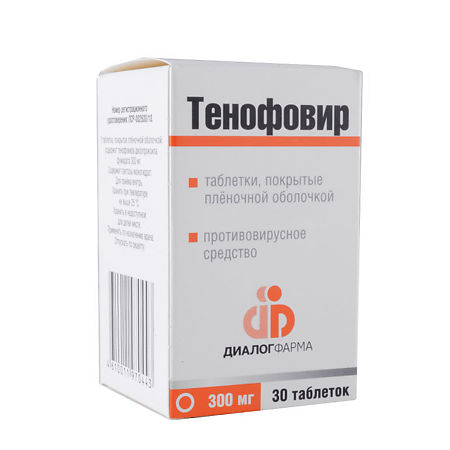No products in the cart.
Description
Pharmacodynamics
Tenofovir disoproxil fumarate in vivo is converted to tenofovir, a nucleoside monophosphate (nucleotide) analogue of adenosine monophosphate. Tenofovir is subsequently converted to its active metabolite, tenofovir diphosphate. Tenofovir is a nucleotide reverse transcriptase inhibitor with specific activity against human immunodeficiency virus (HIV-1 and HIV-2).
Pharmacokinetics
In oral administration on an empty stomach, the bioavailability of tenofovir is approximately 25% and up to 40% (with meals); it improves when taken with meals, especially those high in fat. There is no clinically significant effect of food intake on the effectiveness of tenofovir.
After a single oral administration on an empty stomach of a dose of 300 mg, the maximum serum concentration is reached after 1±0.4 h. Tenofovir pharmacokinetics is dose-dependent. The elimination half-life (T1/2) from the cell is > 60 h; After single oral administration of tenofovir, the T1/2 of tenofovir is approximately 17 h.
After multiple oral doses of 300 mg once daily (not on an empty stomach), 32+10% of the dose taken is detected in the urine for more than 24 hours. Tenofovir is excreted by the kidneys, by glomerular filtration and active tubular secretion.
Indications
Indications
Active ingredient
Active ingredient
Composition
Composition
How to take, the dosage
How to take, the dosage
Orally, regardless of meals.
The recommended dose for the treatment of HIV-1 infection: 300 mg once daily.
Recommended dosing regimen for Tenofovir in renal failure: Creatinine clearance 30-49 ml/min: 300 mg every 48 hours. Creatinine clearance 10-29 mL/min: 300 mg every 72-96 h.
Hemodialysis: 300 mg every 7 days after completion of a dialysis session.
There are no dosing recommendations for patients with creatinine clearance less than 10 ml/min (without hemodialysis).
Interaction
Interaction
Special Instructions
Special Instructions
Cases of lactate acidosis and severe hepatomegaly with steatosis, including death, have been reported with nucleoside analogues;
First-time or progressive renal failure may lead to acute renal failure and Fanconi syndrome. Creatinine clearance should be determined before starting tenofovir treatment. Monitoring of serum creatinine and phosphorus clearance is necessary in patients with an increased risk of development or progression of renal failure. Tenofovir should be avoided concomitantly or after recent treatment with nephrotoxic drugs.
The use of tenofovir concomitantly with combination antiviral drugs that include tenofovir (e.g., Truvada, Atripla) and adefovir depivoxil should be avoided. Tenofovir should only be used as part of appropriate antiretroviral combination therapy in HIV-1-infected patients.
Decreased bone density has been observed in HIV-1-infected patients. Bone density should be monitored in patients with a history of pathological fracture, as well as in patients at increased risk of osteopenia. Redistribution/accumulation of fat was observed in HIV-infected patients receiving combined antiretroviral therapy.
The immune reconstitution syndrome was observed in HIV-infected patients. Further evaluation and treatment may be needed.
Nephrotoxicity
Fanconi syndrome with hypophosphatemia, hypouricemia, proteinuria, normoglycemic glucosuria may develop when Tenofovir is used; in some cases acute renal failure may occur.
In the early stages, the course may be asymptomatic or accompanied by myalgias; in most cases, symptoms disappear when the drug is discontinued. Risk factors include low body weight, and the presence of renal disease at the time of initiation of therapy. The incidence of nephrotoxic side effects is very low in patients with baseline normal renal function.
Resistance
Sensitivity is reduced in patients with three or more resistance mutations to thymidine analogues including 41L and 210W. Sensitivity persists in other combinations of thymidine mutations and is increased in the presence of the M184V mutation.
Contraindications
Contraindications
Tenofovir is contraindicated in patients with hypersensitivity to any component of the drug.
Cautions
Renal insufficiency with a creatinine clearance of less than 50 mL/min, including patients on hemodialysis. If creatinine clearance is less than 30 mL/min, use of the drug should be avoided; if no other treatment is available, renal function should be monitored carefully and the interval between doses of the drug should be adjusted.
Side effects
Side effects
The following are adverse reactions with a suspected (possible) association with the drug, which are listed by system-organ class in descending order of severity, with the following frequency: very common (>1/10) and common (> 1/100, < 1/10), rare (> 1/10000, < 1/1000), very rare (< 1/10000), including individual cases.
Metabolic and nutritional disorders: very common – hypophosphatemia.
Nervous system disorders: very common – dizziness.
Gastrointestinal tract: very often – diarrhea, vomiting, nausea; often – flatulence.
Combination retroviral therapy has been associated with metabolic disorders such as hypertriglyceridemia, hypercholesterolemia, insulin resistance, hyperglycemia and hyperlactatemia; redistribution of subcutaneous fat (lipodystrophy).
Cases of osteonecrosis have been reported, especially in patients with risk factors or with long-term combination antiviral therapy. The frequency is unknown.
Postmarketing experience
Metabolic and nutritional disorders: rare – lactate acidosis, frequency unknown – hypokalemia
Respiratory, thoracic and mediastinal disorders: very rare – dyspnea.
Gastrointestinal tract: rarely – pancreatitis.
Hepatobiliary system: rare – increased transaminase activity; very rare – hepatitis, frequency unknown – hepatic steatosis.
Skin and subcutaneous tissue: rare – rash.
Musculoskeletal system: frequency unknown – rhabdomyolysis, osteomalacia, muscle weakness, myopathy.
Urinary system disorders: rare – acute renal failure, proximal renal tubulopathy (including Fanconi syndrome), hypercreatininemia; very rare – acute tubular necrosis; frequency unknown – nephritis (including acute interstitial), nephrogenic non-sugar diabetes.
General disorders and changes at the site of administration: very rare – asthenia.
Overdose
Overdose
In case of overdose, the patient should be examined for possible signs of intoxication.
If necessary, standard supportive therapy is used.
Tenofovir is effectively removed by hemodialysis with an extraction rate of approximately 54%.
After taking 300 mg of tenofovir, a 4-hour hemodialysis procedure results in removal of approximately 10% of the tenofovir dose taken.
Pregnancy use
Pregnancy use
Additional information
| Shelf life | 2 years |
|---|---|
| Conditions of storage | At a temperature not higher than 25 ° C. |
| Manufacturer | Makiz-Pharma, Russia |
| Medication form | pills |
| Brand | Makiz-Pharma |
Related products
Buy Tenofovir 300 mg 30 pcs. with delivery to USA, UK, Europe and over 120 other countries.










